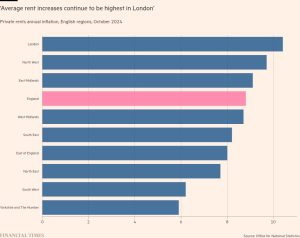a weekend in Paris’s hip and hilly 20th arrondissement
This article is part of FT Globetrotter’s guide to Paris
Far from the dizzying centre of Baron Haussmann’s elegant spiral is one of Paris’ best-kept secrets. Perched on a hill high up in the 20th arrondissement with stunning views of Paris, the former town of Belleville and the adjacent hamlet of Ménilmontant retain much of their rural character with charming cobblestone alleyways, outdoor markets and friendly bars, providing the perfect antidote to the frenetic intensity in the centre.
“Even on a street like this, sometimes there are no cars for two or three minutes — there’s less honking,” says journalist Pauline Pellissier, author of local blog Mon Petit 20e. We are having an espresso in Aux Petits Oignons, a typically Parisian bistro at the upper edges of Ménilmontant and my first stop as I start to explore the neighbourhood.

“It’s more residential. It’s a neighbourhood where people live, and there aren’t many hotels or many tourists,” Pellissier continues. “There are neighbourhoods that are 40 to 50 per cent social housing, so this mix is going to last.”
Much of this social housing went up after slum clearances in the 1950s. This postwar reconstruction effort swept aside the childhood home of the writer Georges Perec. Of Jewish descent, Perec lost his mother in the Holocaust and much of his writing speaks of a longing to reconstruct a past that left no physical traces.
“Space melts like sand running through one’s fingers. Time bears it away and leaves me only shapeless shreds,” he writes in 1974’s Espèces d’espaces (Species of Spaces). These words resonate when I reach the next stop on my itinerary, the aptly named Passage des Soupirs (Passage of Sighs), one of many cobblestoned alleys that escaped the bulldozers. Dense with vegetation, these little green shards pierce the urban fabric and might well have provoked a bittersweet sense of nostalgia in the local author, whose ashes now rest close by in Père-Lachaise cemetery.

But I’m not here to join the crowds paying homage to Paris’s dead celebrities. Instead, I head to Pavillon Carré de Baudouin. This summer residence was built in the 18th century and once sat among the vineyards that spilled down the slopes. Recently refurbished, the bright lofty rooms now serve as a gallery with shows that are free to the public. When I visit, a dancer is gliding around one of the rooms, bringing to life an exhibition of photographs of encounters between patients of Sainte-Anne psychiatric hospital and dancers from the Ballet de l’Opéra National de Paris. Hung outside the building are artist Clément Gy’s charming sketches of the neighbourhood. (Catch these exhibitions until September 21.)
Right beside it the Villa de l’Ermitage — a pretty alley dripping with vines and carefully tended pot plants — gives another glimpse of Belleville’s past. In yet another snaking side street, I stop by Le Jourdain, a chic little restaurant with friendly wait staff who seem to thrive off the bustle of the lunchtime crowd. The food is an exciting melding of Mediterranean influences, and I opt for a tuna steak with chickpea salad. The fish is perfectly seared outside and still pink inside, while sliced pickles add an acidic spike to the salad — and though the portion is enormous, the bill comes to just €18.


The sheer quantity of this feast means that I have to take a breather while staggering over the bridge that crosses the Petite Ceinture, a defunct circular railway that once marked the outer edges of Paris. The city has opened up sections of track to the public and today it is exploding with wildflowers, a prelude to the incredible view at my next destination.
At the rooftop bar of La Bellevilloise, a young trendy crowd stretches out on deckchairs, seemingly knocked flat by breathtaking views of Paris with Montmartre, the Eiffel Tower and Notre-Dame sparkling in the distance.
The Bellevilloise is now a privately run arts venue with a programme of concerts and club nights. It’s a gorgeously curated space (so I’m astonished my espresso comes to only €2.50), with a hammer and sickle above the door marking the institution’s socialist origins. Originally a local co-operative, the Bellevilloise project began in 1877 shortly after a particularly dark episode in Paris’s history.


Local guide Cédric Chapelle of Paris B-sides fills me in: “When Haussmann and Napoleon III decided to integrate Belleville and Ménilmontant into Paris in 1860, resentment grew among the working classes. This culminated when the bourgeoisie allowed a military government based in Versailles to take control of Paris in 1871.”
This conflict came to a head that year during “Bloody Week”, following the Paris Commune, when a working-class revolution was brutally put down. While it was easy for the army to beat the rebels on the wide Haussmannian boulevards of Paris, resistance lasted longer in the poorer parts of the city.
“The last two neighbourhoods resisting were Montmartre and Belleville because they have the same configuration: they’re both on hills with narrow streets. And this history continues today because it’s still a very radical area,” says Chapelle.
Evidence of this radical spirit can be seen in the work of Dugudus, a local street artist and illustrator whose politically charged images grace the walls of Belleville. For more street art, I head to the graffiti-covered Rue Denoyez, where I spy a paste-up portrait of Georges Perec. Cat on shoulder, he twinkles down from on high, his place in local lore assured.


Feeling peckish, I then take Pellissier’s advice and nip into a “hyper-Parisian” restaurant in the backstreets near Belleville Métro station, the kind of place that remains frozen in time and untouched by globalised Instagram trends. Chez Véro is a cosy space with dark-wood panelling inside and a pleasant terrace outside, while the food is locally sourced and seasonal. Focusing mainly on French classics, the menu also incorporates Italian, Georgian and Egyptian influences. I enjoy a beautifully presented asparagus risotto for €18.
As it begins to get dark I head to Aux Folies for a taste of Belleville’s nightlife. The enormous terrace is dense with an unpretentious crowd of young locals gesticulating wildly, so I drink my Sauvignon (€4 for a generous glass) by the neon-lit bar and watch mini-dramas unfold on the street outside.

Luckily, Aux Folies is handy for my hotel, the Babel on Rue Lemon, a peaceful little haven with a blue-tiled exterior and ochre tones in its interior. Staying true to the neighbourhood’s international mix, the venue’s restaurant boasts an inventive menu fusing north African and Asian elements, while hanging drapery evokes the feel of a Bedouin encampment.
One of the most striking things about Belleville is its rich diversity, a side I’m eager to explore on my second day. After a filling continental breakfast at Babel, I take the bus up the hill to Place des Fêtes, an outdoor market (open Tuesday, Friday and Sunday) that not only showcases French food with a dazzling display of local bread and cheeses but also the district’s more diverse heritage. Maison Thiam, for instance, sells all manner of exotic treats including nem, a Senegalese version of Vietnamese spring rolls.


Satisfied with the visual feast, I begin to make my way down Rue de Belleville, where I spot a portrait of Édith Piaf on the building next to No 72, where the chanteuse is said to have been born in the doorway. The area’s most famous celebrity, Piaf went from rags to riches after beginning her career singing on the streets of Belleville.
This is also where Belleville’s Chinese community settled but, while there’s a good selection of Asian restaurants, today I’m eating lunch with a view at Les Bols d’Antoine. This homely vegan restaurant has a great view towards the Eiffel Tower but it seems like the resident black cat is an even bigger attraction. After greeting the laid-back feline, I opt for a deliciously meaty jackfruit burger that pairs perfectly with the cheddar topping and barbecue sauce. Even healthier choices served in colourful bowls look equally appetising.
After lunch, I check out the artisanal market at the viewpoint opposite. Open on weekends from May through September, it offers a small but diverse range of stalls selling quirky fashions and headbands handmade from bright African fabrics. Next, I saunter around the upper reaches of Parc de Belleville, the highest park in Paris, where locals enjoy picnics on the grass.
Rounding the weekend off, I drift downhill to Lou Pascalou, a bare-bones bar with a stage out back where you can catch anything from funk to flamenco acts. I’m here on a quieter summer afternoon, but it’s happy hour and the atmosphere is still suitably lively. When I order my Chardonnay, I ask about the music programme in my creaky French, cringing in the expectation of an exasperated sigh. But the derisive Parisian pfft never comes. The waiter simply smiles patiently as I search for the right words. And then it hits me: this is Paris and yet not Paris, a place to relax and enjoy life at a different pace.
Felicity Hughes was a guest of Babel hotel; double, from €178. Paris B-Sides tours of Belleville and Ménilmontant are from €150
Do you have any Belleville recommendations? Share them in the comments below. And follow FT Globetrotter on Instagram at @FTGlobetrotter
Cities with the FT

FT Globetrotter, our insider guides to some of the world’s greatest cities, offers expert advice on eating and drinking, exercise, art and culture — and much more
Find us in Paris, Rome, London, Tokyo, New York, Frankfurt, Singapore, Hong Kong, Miami, Toronto, Madrid, Melbourne, Copenhagen, Zürich, Milan, Vancouver and Edinburgh
#weekend #Pariss #hip #hilly #20th #arrondissement








